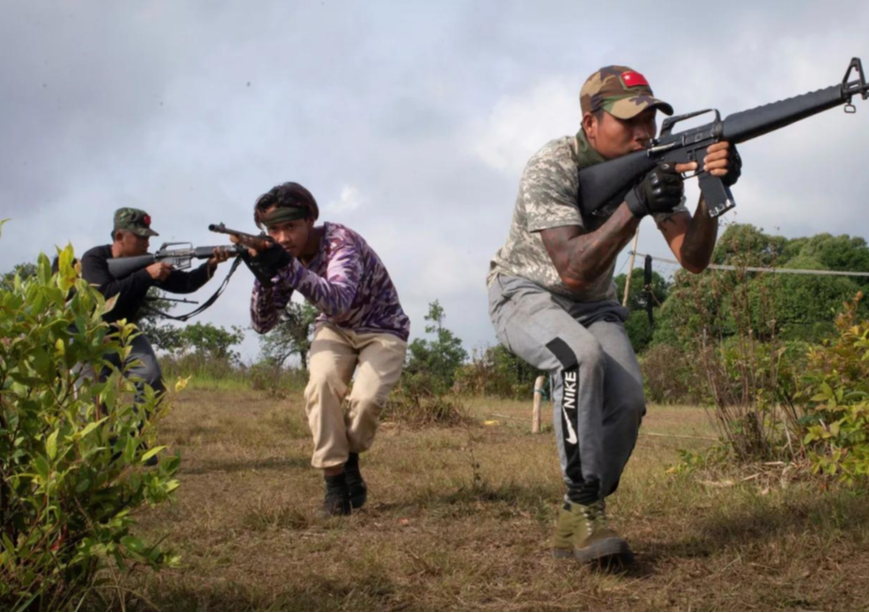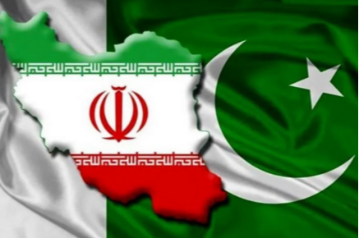
Source Image: Courtesy WPR (World Politics Review)
The photograph of Major-General Chris Donahue—the last United States (US) soldier to leave Afghanistan on 30 August 2021—stepping onto the tail ramp of a C-17 Globemaster, flying out of Kabul was as symbolic of the culmination of the US’ two-decade-long ‘Global War on Terror’ (GWOT) as it was of a change in the political tectonics of insurgency. Even as multipolar contestation comes to occupy the space long occupied by counterterrorism within the broader global strategic imagination, insurgency—which shaped GWOT—has come to simply be driven by and influenced by the international strategic environment in which it is now pursued.
The civil war in Myanmar provides a vignette of what insurgency may look like in this new era. Myanmar is already a key region of concern for Indian policymakers. Besides concerns emanating from a shared border, mutual people-to-people ties, and the security repercussions for India’s Northeast at a time when the region is developing into a fulcrum for New Delhi’s Act East policy, New Delhi’s policies are also shaped by the displacement of Pakistan by China within its strategic calculus—the latter being a more active participant within Myanmar’s security landscape, supporting a variety of belligerents including the Junta itself. Tactics and strategies employed by insurgents might, therefore, provide a glimpse into the future of insurgency amid multipolarity—the likely trends that may develop, and how they might help shape the coming global order.
Tactics and strategies employed by insurgents might, therefore, provide a glimpse into the future of insurgency amid multipolarity—the likely trends that may develop, and how they might help shape the coming global order.
What’s different?
The legacy of counterterrorism over the past two decades is deeply embedded within contemporary visualisations and praxis of insurgency and counterinsurgency and is unlikely to fade away anytime soon, as practitioners worldwide continue to draw lessons from recent examples such as the Israel-Hamas war. Yet the overarching backdrop of multipolarity will inevitably have a greater impact on the practice and politics of insurgency in the coming years.
Unlike the insurgencies occurring as part of the “War on Terror”, ‘great power insurgencies’—such as the one in Myanmar—serve to express the networked and horizontal structures of multipolarity defining modern international politics. The indictment of Yakuza boss Takeshi Ebisawa in February by US agencies on charges of nuclear proliferation from Myanmar to the Iranian government—the profits of which were to be divided between the Japanese national and an unnamed insurgent outfit in Myanmar—is demonstrative of a key feature of the international system that is likely to manifest in similar ways in future insurgencies. First, the far-reaching ambitions that middle/regional powers such as Iran seek to exercise in pursuit of long-term strategic interests. As interconnectedness grows, and with it, the capabilities of extra-regional middle powers to derive outsized strategic dividends, insurgencies are likely to be driven by actors seeking to satisfy their demands. This would include organised criminal syndicates and disaffected militant organisations seeking to leverage their services for state support.
As interconnectedness grows, and with it, the capabilities of extra-regional middle powers to derive outsized strategic dividends, insurgencies are likely to be driven by actors seeking to satisfy their demands.
Regional connectivity programmes and access to/innovation in critical national infrastructure (CNI) also serve as physical manifestations of multipolar strategic competition and will come to define the trajectory that insurgencies such as the one in Myanmar may take in the future. Souring ties between India and China have increasingly come to manifest in Myanmar, where both countries vie for geopolitical influence by investing in CNI and regional connectivity projects. Evolving insurgent tactics in a world order characterised by multipolarity competition may therefore be characterised by overt proximity between militant actors and their state backers seeking to disrupt or deny adversaries’ use of such physical projections of power. Illustrative of the interconnected character of the modern world order, insurgent attacks on supply chains and CNI in war zones may have wider implications. It can grant governments the leverage needed to gain concessions from the other side—for instance, the attacks on the India-funded Kaladan Multimodal Transport Corridor in Myanmar by the pro-China ethnic armed organisation (EAO) the Arakan Army. Through its deliberate disruption of movement along the corridor and subsequent initiation of negotiations with Indian authorities to presumably reopen it, the Arakan Army illustrates yet another insurgent strategy in the Myanmar civil war that, while common, will become a more central element of irregular warfare in the future.
Situating China
Likewise, the civil war in Myanmar provides insight into China’s potential growth as a security actor in both the land and the maritime domains. While China’s emergence as a revisionist force in international security has been marked, among other factors, by its growing maritime belligerence in the Indo-Pacific, the civil war in Myanmar and China’s role within it has provided observers with a glimpse into Beijing’s strategies towards land-based insurgencies in a multipolar world order.
China’s support for both the Junta and rebel groups conducting operations under the Three Brotherhood Alliance (TBA) is reflective of both its strategy of mitigating losses through the establishment of relations with both sides in a conflict and mitigating Beijing’s immediate strategic concerns and lack of control over ongoing developments.
China’s support for both the Junta and rebel groups conducting operations under the Three Brotherhood Alliance (TBA) is reflective of both its strategy of mitigating losses through the establishment of relations with both sides in a conflict, but also mitigating Beijing’s immediate strategic concerns and lack of control over ongoing developments. Launched in October 2023 as a coordinated offensive by the TBA, sanctioned by China, against the Junta and organised criminal syndicates colluding with it, Operation 1027 reflected China’s success in maintaining a long-term political presence within Myanmar—establishing contingencies through close ties with the rebel groups, while parallelly continuing to cooperate with the Junta through arms sales, economic cooperation and diplomatic support. Such a strategy may be demonstrative of China’s reach, and how it seeks to leverage it for geopolitical gain. Indeed, the TBA has sought to vocalise its closeness to Beijing by amplifying concerns surrounding the entrenchment of criminal organisations within Myanmar’s political landscape as it was aware of Chinese security concerns about illicit activities by regional criminal syndicates along the border and their close ties with the military.
Strategies such as these may provide a glimpse of the means that China may employ by leveraging insurgencies to exercise political will. Supporting belligerent sides, and using one to weaken another to make strategic gains, before calibrating its political influence with either to broker agreement and hence, deepen its economic and political presence vis-à-vis ‘adversary’ states appears to be a strategy that China may use in the future insurgencies. Recent cases, such as the China-brokered ceasefire between the Junta and the TBA, seem to prove this point. A line of policy such as this also highlights the influence of multipolarity on the politics of such conflicts in the future. By intervening first and extending a strategic choice to both sides of an insurgency, China can leverage its presence to exercise greater strategic power vis-à-vis other states.
However, China’s decision to sanction Operation 1027 also reflects the limits of its power and a potential vulnerability which may continue to characterise its approach towards regional small wars in the future. The fact that the Junta only distanced itself somewhat from organised criminal syndicates after a China-backed insurgent offensive despite its supposedly close ties with Beijing—and even then, openly sanctioning anti-Chinese mass protests in its aftermath—proves that Chinese influence in local insurgencies can only go so far.
Ultimately, the insurgency in Myanmar provides a foretaste of the future political dynamics of insurgency. With the “War on Terror” rapidly passing into history and the advent of multipolar competition, insurgents and counter-insurgents will need to adapt to a different strategic zeitgeist. The extent to which they do so will determine their eventual success or failure.
Archishman Goswami is a postgraduate student studying the MPhil International Relations programme at the University of Oxford.
The views expressed above belong to the author(s). ORF research and analyses now available on Telegram! Click here to access our curated content — blogs, longforms and interviews.




 PREV
PREV


